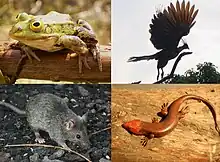Tetrapodomorpha
The Tetrapodomorpha (also known as Choanata[3]) are a clade of vertebrates consisting of tetrapods (four-limbed vertebrates) and their closest sarcopterygian relatives that are more closely related to living tetrapods than to living lungfish. Advanced forms transitional between fish and the early labyrinthodonts, such as Tiktaalik, have been referred to as "fishapods" by their discoverers, being half-fish, half-tetrapods, in appearance and limb morphology. The Tetrapodomorpha contains the crown group tetrapods (the last common ancestor of living tetrapods and all of its descendants) and several groups of early stem tetrapods, which includes several groups of related lobe-finned fishes, collectively known as the osteolepiforms. The Tetrapodomorpha minus the crown group Tetrapoda are the stem Tetrapoda, a paraphyletic unit encompassing the fish to tetrapod transition.
| Tetrapodomorpha | |
|---|---|
 | |
| The advanced tetrapodomorph Tiktaalik | |
 | |
| Modern tetrapods | |
| Scientific classification | |
| Domain: | Eukaryota |
| Kingdom: | Animalia |
| Phylum: | Chordata |
| Clade: | Sarcopterygii |
| Clade: | Rhipidistia |
| Clade: | Tetrapodomorpha Ahlberg, 1991 |
| Subgroups | |
See also below. | |
Among the characteristics defining tetrapodomorphs are modifications to the fins, notably a humerus with convex head articulating with the glenoid fossa (the socket of the shoulder joint). Another key trait is the internal nostril or choana. Most fish have two pairs of nostrils, one on either side of the head for incoming water (incurrent nostrils) and another pair for outgoing water (excurrent nostrils). Early tetrapodomorphs such as Kenichthys had excurrent nostrils that had migrated to the edge of the mouth. In later tetrapodomorphs, including tetrapods, the excurrent nostril is positioned inside the mouth, where it is known as the choana.[4] The nearly-equivalent clade Choanata often refers to these later forms specifically.[2]
Tetrapodomorph fossils are known from the early Devonian onwards, and include Osteolepis, Panderichthys, Kenichthys and Tungsenia.[1]
Classification


Taxonomy
After Benton, 2004;[6] and Swartz, 2012.[7]
- Subclass Sarcopterygii
- Infraclass Tetrapodomorpha
- Order †Rhizodontida
- Family †Sauripteridae
- Family †Rhizodontidae
- Superorder †Osteolepidida (or Osteolepiformes)
- Family †Canowindridae
- Family †Thysanolepidae
- Family †Tristichopteridae
- Order †Osteolepiformes (or Megalichthyiformes)
- Family †Osteolepidae
- Family †Megalichthyidae
- Clade Eotetrapodiformes
- Clade Elpistostegalia (or Panderichthyida)
- Clade Stegocephalia
- Family †Elpistostegidae
- Family †Whatcheeriidae
- Family †Colosteidae
- Superfamily †Baphetoidea
- Superclass Tetrapoda
Other clades include the Eotetrapodiformes (Tinirau, Platycephalichthys, the Tristichopteridae and Elpistostegalia).[7] Older taxa which include late stem tetrapods and early tetrapods are the Labyrinthodontia and Ichthyostegalia.
Relationships
The cladogram is based on a phylogenetic analysis of 46 taxa using 204 characters by B. Swartz in 2012.[7]
| Tetrapodomorpha |
| |||||||||||||||||||||||||||||||||||||||||||||||||||||||||||||||||||||||||||||||||||||||||||||||||||||||||||||||||||||||||||||||||||||||||||||||||||||||||||||||||||||||||||||||||||||||||||||
The following cladogram follows the results found by Clement et al. (2021).[8]
| Tetrapodomorpha |
| |||||||||||||||||||||||||||||||||||||||||||||||||||||||||||||||||||||||||||||||||||||||||||||||||||||||||||||||||||||||||||||||||||||||||||||||||||||||||||||||||||||||||||||||||||||||||||||||||||
References
- Lu, J.; Zhu, M.; Long, J. A.; Zhao, W.; Senden, T. J.; Jia, L.; Qiao, T. (2012). "The earliest known stem-tetrapod from the Lower Devonian of China". Nature Communications. 3: 1160. Bibcode:2012NatCo...3.1160L. doi:10.1038/ncomms2170. hdl:1885/69314. PMID 23093197.
- Merck, John. "And Now For Something Completely Different: Sarcopterygii".
- Zhu Min; Schultze, Hans-Peter (11 September 2002). Per Erik Ahlberg (ed.). Major Events in Early Vertebrate Evolution. CRC Press. p. 296. ISBN 978-0-203-46803-6. Retrieved 5 August 2015.
- Clack, Jennifer A. (2012). Gaining Ground: The Origin and Evolution of Tetrapods. Indiana University Press. p. 74. ISBN 978-0-253-35675-8. Retrieved 8 June 2015.
- Friedman, Matt; Brazeau, Martin D. (7 February 2011). "Sequences, stratigraphy and scenarios: what can we say about the fossil record of the earliest tetrapods?". Proceedings of the Royal Society B. 278 (1704): 432–439. doi:10.1098/rspb.2010.1321. PMC 3013411. PMID 20739322.
- "VERTAPPENDIX". palaeo.gly.bris.ac.uk. Archived from the original on 2005-03-21.
- Swartz, B. (2012). "A marine stem-tetrapod from the Devonian of Western North America". PLOS ONE. 7 (3): e33683. Bibcode:2012PLoSO...733683S. doi:10.1371/journal.pone.0033683. PMC 3308997. PMID 22448265.
- Clement, Alice M.; Cloutier, Richard; Lu, Jing; Perilli, Egon; Maksimenko, Anton; Long, John (2021-12-10). "A fresh look at Cladarosymblema narrienense, a tetrapodomorph fish (Sarcopterygii: Megalichthyidae) from the Carboniferous of Australia, illuminated via X-ray tomography". PeerJ. 9: e12597. doi:10.7717/peerj.12597. ISSN 2167-8359.
- Mikko Haaramo. "Tetrapodomorpha – Terrestrial vertebrate-like sarcopterygians". Archived from the original on 12 May 2006. Retrieved 6 April 2006.
- P. E. Ahlberg & Z. Johanson (1998). "Osteolepiforms and the ancestry of tetrapods". Nature. 395 (6704): 792–794. Bibcode:1998Natur.395..792A. doi:10.1038/27421. S2CID 4430783.
- Michel Laurin, Marc Girondot & Armand de Ricqlès (2000). "Early tetrapod evolution" (PDF). TREE. 15 (3).
.jpg.webp)




